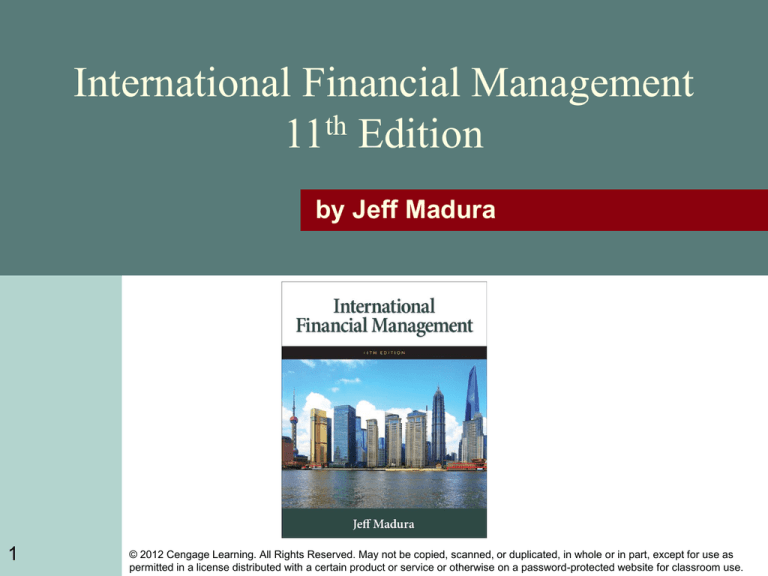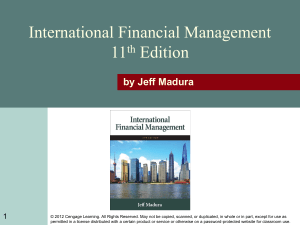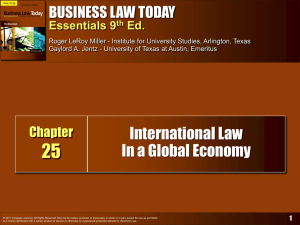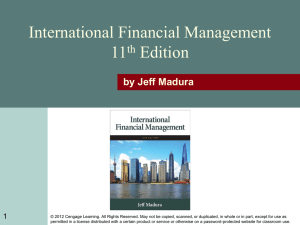
International Financial Management
11th Edition
by Jeff Madura
1
© 2012 Cengage Learning. All Rights Reserved. May not be copied, scanned, or duplicated, in whole or in part, except for use as
permitted in a license distributed with a certain product or service or otherwise on a password-protected website for classroom use.
5 Currency Derivatives
Chapter Objectives
Explain how forward contracts are used to hedge based
on anticipated exchange rate movements
Describe how currency futures contracts are used to
speculate or hedge based on anticipated exchange rate
movements
Explain how currency option contracts are used to
speculate or hedge based on anticipated exchange rate
movements
2
© 2012 Cengage Learning. All Rights Reserved. May not be copied, scanned, or duplicated, in whole or in part, except for use as
permitted in a license distributed with a certain product or service or otherwise on a password-protected website for classroom use.
What is a Currency Derivative?
1. A currency derivative is a contract whose price is
derived from the value of an underlying currency.
2. Examples include forwards/futures contracts and
options contracts.
3. Derivatives are used by MNCs to:
a. Speculate on future exchange rate movements
b. Hedge exposure to exchange rate risk
3
© 2012 Cengage Learning. All Rights Reserved. May not be copied, scanned, or duplicated, in whole or in part, except for use as
permitted in a license distributed with a certain product or service or otherwise on a password-protected website for classroom use.
Forward Market
A forward contract is an agreement between a
corporation and a financial institution:
4
To exchange a specified amount of currency
At a specified exchange rate called the forward rate
On a specified date in the future
© 2012 Cengage Learning. All Rights Reserved. May not be copied, scanned, or duplicated, in whole or in part, except for use as
permitted in a license distributed with a certain product or service or otherwise on a password-protected website for classroom use.
How MNCs Use Forward Contracts
Hedge their imports by locking in the rate at which
they can obtain the currency
Bid/Ask Spread is wider for less liquid currencies.
May negotiate an offsetting trade if an MNC enters
into a forward sale and a forward purchase with the
same bank.
Non-deliverable forward contracts (NDF) can be used
for emerging market currencies where no currency
delivery takes place at settlement, instead one party
makes a payment to the other party.
5
© 2012 Cengage Learning. All Rights Reserved. May not be copied, scanned, or duplicated, in whole or in part, except for use as
permitted in a license distributed with a certain product or service or otherwise on a password-protected website for classroom use.
Premium or Discount on the Forward Rate
F = S(1 + p)
where:
F is the forward rate
S is the spot rate
p is the forward premium, or the percentage by
which the forward rate exceeds the spot rate.
6
© 2012 Cengage Learning. All Rights Reserved. May not be copied, scanned, or duplicated, in whole or in part, except for use as
permitted in a license distributed with a certain product or service or otherwise on a password-protected website for classroom use.
Exhibit 5.1 Computation of Forward Rate Premiums or
Discounts
7
© 2012 Cengage Learning. All Rights Reserved. May not be copied, scanned, or duplicated, in whole or in part, except for use as
permitted in a license distributed with a certain product or service or otherwise on a password-protected website for classroom use.
Premium or Discount on the Forward Rate
Arbitrage – If the forward rate was the same as the spot rate,
arbitrage would be possible.
Movements in the Forward Rate over Time – The forward
premium is influenced by the interest rate differential
between the two countries and can change over time.
Offsetting a Forward Contract – An MNC can offset a
forward contract by negotiating with the original counterparty
bank.
Non-deliverable forward contracts (NDF) can be used for
emerging market currencies where no currency delivery takes
place at settlement; instead one party makes a payment to the
other party.
8
© 2012 Cengage Learning. All Rights Reserved. May not be copied, scanned, or duplicated, in whole or in part, except for use as
permitted in a license distributed with a certain product or service or otherwise on a password-protected website for classroom use.
Currency Futures Market
Similar to forward contracts in terms of obligation to
purchase or sell currency on a specific settlement date
in the future.
Differ from forward contracts because futures have
standard contract specifications:
a. Standardized number of units per contract (See Exhibit 5.2)
b. Offer greater liquidity than forward contracts
c. Typically based on U.S. dollar, but may be offered on crossrates.
d. Commonly traded on the Chicago Mercantile Exchange
(CME).
9
© 2012 Cengage Learning. All Rights Reserved. May not be copied, scanned, or duplicated, in whole or in part, except for use as
permitted in a license distributed with a certain product or service or otherwise on a password-protected website for classroom use.
Exhibit 5.2 Currency Futures Contracts Traded on the
Chicago Mercantile Exchange
10
© 2012 Cengage Learning. All Rights Reserved. May not be copied, scanned, or duplicated, in whole or in part, except for use as
permitted in a license distributed with a certain product or service or otherwise on a password-protected website for classroom use.
Trading Currency Futures
Firms or individuals can execute orders for currency
futures contracts by calling brokerage firms.
Electronic trading platforms facilitate the trading of
currency futures. These platforms serve as a broker,
as they execute the trades desired.
Currency futures contracts are similar to forward
contracts in that they allow a customer to lock in the
exchange rate at which a specific currency is
purchased or sold for a specific date in the future.
11
© 2012 Cengage Learning. All Rights Reserved. May not be copied, scanned, or duplicated, in whole or in part, except for use as
permitted in a license distributed with a certain product or service or otherwise on a password-protected website for classroom use.
Exhibit 5.3 Comparison of the Forward and Futures Market
12
Source: Chicago Mercantile Exchange
© 2012 Cengage Learning. All Rights Reserved. May not be copied, scanned, or duplicated, in whole or in part, except for use as
permitted in a license distributed with a certain product or service or otherwise on a password-protected website for classroom use.
Trading Currency Futures (cont.)
Pricing Currency Futures - The price of currency
futures will be similar to the forward rate
Credit Risk of Currency Futures Contracts To minimize its risk, the CME imposes margin
requirements to cover fluctuations in the value of a
contract, meaning that the participants must make a
deposit with their respective brokerage firms when
they take a position.
13
© 2012 Cengage Learning. All Rights Reserved. May not be copied, scanned, or duplicated, in whole or in part, except for use as
permitted in a license distributed with a certain product or service or otherwise on a password-protected website for classroom use.
How Firms Use Currency Futures
Purchasing Futures to Hedge Payables - The
purchase of futures contracts locks in the price at
which a firm can purchase a currency.
Selling Futures to Hedge Receivables - The
sale of futures contracts locks in the price at which a
firm can sell a currency.
14
© 2012 Cengage Learning. All Rights Reserved. May not be copied, scanned, or duplicated, in whole or in part, except for use as
permitted in a license distributed with a certain product or service or otherwise on a password-protected website for classroom use.
Closing Out a Futures Position
Sellers (buyers) of currency futures can close
out their positions by buying (selling)
identical futures contracts prior to settlement.
Most currency futures contracts are closed out
before the settlement date.
15
© 2012 Cengage Learning. All Rights Reserved. May not be copied, scanned, or duplicated, in whole or in part, except for use as
permitted in a license distributed with a certain product or service or otherwise on a password-protected website for classroom use.
Exhibit 5.4 Closing Out a Futures Contract
16
© 2012 Cengage Learning. All Rights Reserved. May not be copied, scanned, or duplicated, in whole or in part, except for use as
permitted in a license distributed with a certain product or service or otherwise on a password-protected website for classroom use.
Speculation with Currency Futures
1. Currency futures contracts are sometimes purchased
by speculators attempting to capitalize on their
expectation of a currency’s future movement.
2. Currency futures are often sold by speculators who
expect that the spot rate of a currency will be less than
the rate at which they would be obligated to sell it.
17
© 2012 Cengage Learning. All Rights Reserved. May not be copied, scanned, or duplicated, in whole or in part, except for use as
permitted in a license distributed with a certain product or service or otherwise on a password-protected website for classroom use.
Exhibit 5.5 Source of Gains from Buying Currency
Futures
18
© 2012 Cengage Learning. All Rights Reserved. May not be copied, scanned, or duplicated, in whole or in part, except for use as
permitted in a license distributed with a certain product or service or otherwise on a password-protected website for classroom use.
Currency Futures Market Efficiency
1. If the currency futures market is efficient, the futures
price should reflect all available information.
2. Thus, the continual use of a particular strategy to take
positions in currency futures contracts should not lead
to abnormal profits.
3. Research has found that the currency futures market
may be inefficient. However, the patterns are not
necessarily observable until after they occur, which
means that it may be difficult to consistently generate
abnormal profits from speculating in currency futures.
19
© 2012 Cengage Learning. All Rights Reserved. May not be copied, scanned, or duplicated, in whole or in part, except for use as
permitted in a license distributed with a certain product or service or otherwise on a password-protected website for classroom use.
Currency Options Markets
Currency options provide the right to purchase or sell
currencies at specified prices.
Options Exchanges
1982 - exchanges in Amsterdam, Montreal, and Philadelphia first
allowed trading in standardized foreign currency options.
2007 – CME and CBOT merged to form CME group
Exchanges are regulated by the SEC in the U.S.
Over-the-counter market - Where currency options are
offered by commercial banks and brokerage firms. Unlike the
currency options traded on an exchange, the over-the-counter
market offers currency options that are tailored to the specific
needs of the firm.
20
© 2012 Cengage Learning. All Rights Reserved. May not be copied, scanned, or duplicated, in whole or in part, except for use as
permitted in a license distributed with a certain product or service or otherwise on a password-protected website for classroom use.
Currency Call Options
Grants the right to buy a specific currency at a
designated strike price or exercise price within a
specific period of time.
If the spot rate rises above the strike price, the owner of
a call can exercise the right to buy currency at the strike
price.
The buyer of the option pays a premium.
If the spot exchange rate is greater than the strike price,
the option is in the money. If the spot rate is equal to
the strike price, the option is at the money. If the spot
rate is lower than the strike price, the option is out of
the money.
21
© 2012 Cengage Learning. All Rights Reserved. May not be copied, scanned, or duplicated, in whole or in part, except for use as
permitted in a license distributed with a certain product or service or otherwise on a password-protected website for classroom use.
Factors Affecting Currency Call Option Premiums
The premium on a call option (C) is affected by three factors:
Spot price relative to the strike price (S – X): The higher
the spot rate relative to the strike price, the higher the option
price will be.
Length of time before expiration (T): The longer the time
to expiration, the higher the option price will be.
Potential variability of currency (σ): The greater the
variability of the currency, the higher the probability that the
spot rate can rise above the strike price.
22
© 2012 Cengage Learning. All Rights Reserved. May not be copied, scanned, or duplicated, in whole or in part, except for use as
permitted in a license distributed with a certain product or service or otherwise on a password-protected website for classroom use.
How Firms Use Currency Call Options
Firms can use call options to:
hedge payables
hedge project bidding to lock in the dollar cost of
potential expenses.
hedge target bidding of a possible acquisition.
Speculate on expectations of future movements in a
currency.
23
© 2012 Cengage Learning. All Rights Reserved. May not be copied, scanned, or duplicated, in whole or in part, except for use as
permitted in a license distributed with a certain product or service or otherwise on a password-protected website for classroom use.
Currency Put Options
1. Grants the right to sell a currency at a specified strike
price or exercise price within a specified period of time.
2. If the spot rate falls below the strike price, the owner of a
put can exercise the right to sell currency at the strike
price.
3. The buyer of the options pays a premium.
4. If the spot exchange rate is lower than the strike price,
the option is in the money. If the spot rate is equal to the
strike price, the option is at the money. If the spot rate is
greater than the strike price, the option is out of the
money.
24
© 2012 Cengage Learning. All Rights Reserved. May not be copied, scanned, or duplicated, in whole or in part, except for use as
permitted in a license distributed with a certain product or service or otherwise on a password-protected website for classroom use.
Factors Affecting Put Option Premiums
Put option premiums are affected by three factors:
Spot rate relative to the strike price (S–X): The lower
the spot rate relative to the strike price, the higher the
probability that the option will be exercised.
Length of time until expiration (T): The longer the
time to expiration, the greater the put option premium
Variability of the currency (σ): The greater the
variability, the greater the probability that the option
may be exercised.
25
© 2012 Cengage Learning. All Rights Reserved. May not be copied, scanned, or duplicated, in whole or in part, except for use as
permitted in a license distributed with a certain product or service or otherwise on a password-protected website for classroom use.
Hedging with Currency Put Options
1. Corporations with open positions in foreign currencies
can use currency put options in some cases to cover these
positions.
2. Some put options are deep out of the money, meaning
that the prevailing exchange rate is high above the
exercise price. These options are cheaper (have a lower
premium), as they are unlikely to be exercised because
their exercise price is too low.
3. Other put options have an exercise price that is currently
above the prevailing exchange rate and are therefore more
likely to be exercised. Consequently, these options are
more expensive.
26
© 2012 Cengage Learning. All Rights Reserved. May not be copied, scanned, or duplicated, in whole or in part, except for use as
permitted in a license distributed with a certain product or service or otherwise on a password-protected website for classroom use.
Speculating with Currency Put Options
1. Individuals may speculate with currency put options
based on their expectations of the future movements in a
particular currency.
2. Speculators can attempt to profit from selling currency
put options. The seller of such options is obligated to
purchase the specified currency at the strike price from
the owner who exercises the put option.
3. The net profit to a speculator is based on the exercise
price at which the currency can be sold versus the
purchase price of the currency and the premium paid for
the put option..
27
© 2012 Cengage Learning. All Rights Reserved. May not be copied, scanned, or duplicated, in whole or in part, except for use as
permitted in a license distributed with a certain product or service or otherwise on a password-protected website for classroom use.
Exhibit 5.6 Contingency Graphs for Currency Options
28
© 2012 Cengage Learning. All Rights Reserved. May not be copied, scanned, or duplicated, in whole or in part, except for use as
permitted in a license distributed with a certain product or service or otherwise on a password-protected website for classroom use.
Conditional Currency Options
1. A currency option can be structured with a conditional
premium, meaning that the premium paid for the option is
conditioned on the actual movement in the currency’s value
over the period of concern.
2. Firms also use various combinations of currency options.
29
© 2012 Cengage Learning. All Rights Reserved. May not be copied, scanned, or duplicated, in whole or in part, except for use as
permitted in a license distributed with a certain product or service or otherwise on a password-protected website for classroom use.
Exhibit 5.7 Comparison of Conditional and Basic
Currency Options
30
© 2012 Cengage Learning. All Rights Reserved. May not be copied, scanned, or duplicated, in whole or in part, except for use as
permitted in a license distributed with a certain product or service or otherwise on a password-protected website for classroom use.
European Currency Options
European-style currency options must be exercised on the
expiration date if they are to be exercised at all.
They do not offer as much flexibility; however, this is not
relevant to some situations.
If European-style options are available for the same
expiration date as American-style options and can be
purchased for a slightly lower premium, some corporations
may prefer them for hedging.
31
© 2012 Cengage Learning. All Rights Reserved. May not be copied, scanned, or duplicated, in whole or in part, except for use as
permitted in a license distributed with a certain product or service or otherwise on a password-protected website for classroom use.
SUMMARY
A forward contract specifies a standard volume of a
particular currency to be exchanged on a particular date.
Such a contract can be purchased by a firm to hedge
payables or sold by a firm to hedge receivables.
Futures contracts on a particular currency can be purchased
by corporations that have payables in that currency and wish
to hedge against the possible appreciation of that currency.
Conversely, these contracts can be sold by corporations that
have receivables in that currency and wish to hedge against
the possible depreciation of that currency.
32
© 2012 Cengage Learning. All Rights Reserved. May not be copied, scanned, or duplicated, in whole or in part, except for use as
permitted in a license distributed with a certain product or service or otherwise on a password-protected website for classroom use.
SUMMARY (Cont.)
Currency options are classified as call options or put
options. Call options allow the right to purchase a specified
currency at a specified exchange rate by a specified
expiration date. Put options allow the right to sell a specified
currency at a specified exchange rate by a specified
expiration date. Currency call options are commonly
purchased by corporations that have payables in a currency
that is expected to appreciate. Currency put options are
commonly purchased by corporations that have receivables
in a currency that is expected to depreciate.
33
© 2012 Cengage Learning. All Rights Reserved. May not be copied, scanned, or duplicated, in whole or in part, except for use as
permitted in a license distributed with a certain product or service or otherwise on a password-protected website for classroom use.









